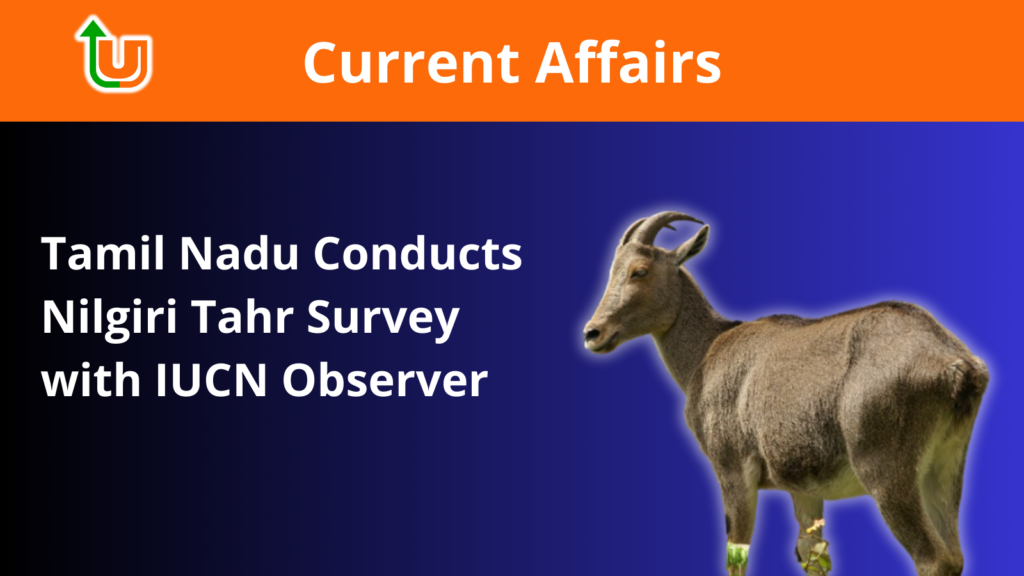The Tamil Nadu government is currently conducting a three-day synchronised survey of the Nilgiri Tahr (Nilgiritragus hylocrius), which is the State animal. The primary objective of this survey is to estimate the population of this endangered species that once freely roamed the Anamalai and Nilgiris landscape.

Collaboration and Methodology
- The survey is being carried out in collaboration with several organizations:
- World Wide Fund for Nature (WWF)
- Wildlife Institute of India (WII)
- International Union for Conservation of Nature (IUCN)
- The habitats in Tamil Nadu have been divided into:
- 13 forest divisions
- 100 forest beats
- 140 feasible blocks
- Emphasis is placed on areas along the Kerala border.
- The survey methodology includes:
- Bounded-count method for all areas
- Double observer method in large contiguous landscapes with major populations, such as Grass Hills National Park, Mukurthi National Park, Silent Valley National Park, and Eravikulam National Park.
Project Nilgiri Tahr
- The survey results will serve as baseline data for Project Nilgiri Tahr.
- Key components of the project:
- Stabilizing the population by addressing threats faced by the mountain ungulates.
- Possible reintroduction of the animal in sites like the Sathyamangalam Tiger Reserve.
Nilgiri Tahr Facts
- The Nilgiri Tahr is a mountain ungulate endemic to the Western Ghats of India.
- It is listed as an endangered species by the IUCN and protected under Schedule-I of the Wildlife (Protection) Act, 1972.
- Threats include habitat loss, fragmentation, poaching, and competition with domestic livestock.
- Nilgiri Tahrs are found in montane grasslands and shola forests at elevations between 1,200 and 2,600 meters.
- They live in social herds, led by adult females, with males forming separate bachelor groups.
Conservation Efforts
- Eravikulam National Park in Kerala, which holds the largest Nilgiri Tahr population, has implemented strict conservation measures.
- Mukurthi National Park in Tamil Nadu was established in 1982 primarily to protect the Nilgiri Tahr and its habitat.
- Captive breeding programs have been initiated in some zoos to maintain a viable population and support reintroduction efforts.
- Collaboration between Tamil Nadu and Kerala, along with leading conservation organizations, highlights the importance of joint efforts in protecting biodiversity in the Western Ghats.
Remember, the Nilgiri Tahr’s survival depends on our collective efforts to conserve its habitat and ensure its continued existence in our natural heritage.
View More Sources
(1) Tamil Nadu Conducts Nilgiri Tahr Survey with IUCN Observer. https://www.gktoday.in/tamil-nadu-conducts-nilgiri-tahr-survey-with-iucn-observer/.
(2) IUCN OBSERVER JOINS NILGIRI TAHR SURVEY TO ASSESS ENDANGERED STATUS.. https://universalinstitutions.com/iucn-observer-joins-nilgiri-tahr-survey-to-assess-endangered-status/.
(3) IUCN representative to be an observer in Tamil Nadu’s Nilgiri Tahr survey. https://www.ksgindia.com/study-material/news/iucn-representative-to-be-an-observer-in-tamil-nadus-nilgiri-tahr-survey.html.
(4) Nilgiri Tahr census: IUCN joins as third party observer, Kerala gives …. https://www.newindianexpress.com/states/tamil-nadu/2024/Apr/26/nilgiri-tahr-census-iucn-joins-as-third-party-observer-kerala-gives-full-support.
Read More:
- Neeraj Chopra: A Golden Throw at Federation Cup 2024

- Sunil Chhetri: A Legend Bows Out from International Football

- A New Dawn: Over 300 Individuals Embrace Indian Citizenship Under CAA

- Pixel Play: HDFC Bank’s Leap into the Future with India’s First Virtual Credit Card

- ‘Lord Curzon Ki Haveli’: A Triumph at the UK-Asian Film Festival





